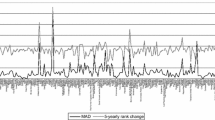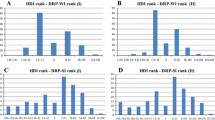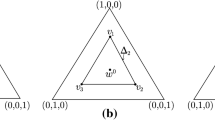Abstract
The United Nations’ Human Development Index (HDI) considers scores in three dimensions – income, school enrolment and literacy rate, longevity – and combines them into a single figure that measures the degree of development of a given country. However, there is disagreement about (1) how to weight the scores in the different dimensions and (2) how to aggregate the weighted scores over the different dimensions. At the risk of stressing the obvious, changes in weighting and/or aggregation will affect the country rankings. First, we focus on robust rankings, i.e., rankings which hold for a wide set of weighting and/or aggregation procedures. Second, we show that all proposed ranking procedures can be implemented via linear programming techniques. Third, we illustrate how our methodology can prove useful in assessing the robustness of the human development country ranking/classification (produced annually by the United Nations) in a descriptive and statistical way.
Similar content being viewed by others
References
Anand, S., Sen, A.: The income component of the human development index. J. Hum. Dev. 1, 83–106 (2000)
Booysen, F.: An overview and evaluation of composite indices of development. Soc. Indic. Res. 59, 115–151 (2002)
Chakravarty, S.R.: A generalized human development index. Rev. Dev. Econ. 7, 99–114 (2003)
Chatterjee, S.K.: Measurement of human development: an alternative approach. J. Hum. Dev. 6, 31–53 (2005)
Cherchye, L., Moesen W., Van Puyenbroeck T.: Legitimately diverse, yet comparable: on synthesising social inclusion performance in the EU. J. Common Mark. Stud. 42, 919–955 (2004)
Dar, H.A.: On making human development more humane. Int. J. Soc. Econ. 31, 1071–1088 (2004)
Despotis, D.K.: A reassessment of the human development index via data envelopment analysis. Int. J. Soc. Econ. 56, 969–980 (2005)
Dowrick, S., Dunlop, Y., Quiggin, J.: Social indicators and comparisons of living standards. J. Dev. Econ. 70, 501–529 (2003)
Fleurbaey, M., Hagneré, C., Trannoy, A.: Welfare comparisons with bounded equivalence scales. J. Econ. Theory 110, 309–336 (2003)
Fukada-Parr, S.: Indicators of human development and human rights – overlaps, differences and what about the human development index? Stat. J. U.N. 18, 239–248 (2001)
Fukada-Parr, S., Shiva Kumar, A.K.: Readings in Human Development. Oxford University Press, Oxford (2003)
Klasen, S., Bardhan, K.: UNDP’s gender-related indices: a critical review. World Dev. 27, 985–1010 (1999)
Lind, N.: Values reflected in the human development index. Soc. Indic. Res. 66, 283–293 (2004)
Luchters, G., Menkhoff, L.: Chaotic signals from HDI measurement. Appl. Econ. Lett. 7, 267–270 (2000)
Maasoumi, E., Nickelsburg, G.: Multivariate measures of well-being and an analysis of inequality in the Michigan data. J. Bus. Econ. Stat. 6, 327–334 (1988)
Mahlberg, B., Obersteiner, M.: Remeasuring the HDI by data envelopment analysis. International Institute for Applied Systems Analysis Interim Report 01-069 (2001)
Mazumdar, K.: A new approach to human development index. Rev. Soc. Econ. 61, 535–549 (2003)
Nardo M., Saisana M., Saltelli A., Tarantola S., Hoffman A., Giovannini E.: Handbook on Constructing Composite Indicators: Methodology and User’s Guide. OECD Statistics Working Paper (JT00188147) (2005)
Noorbakhsh, F.: A modified human development index. World Dev. 26, 517–528 (1998)
Panigrahi R., Sivramkrishna, S.: An adjusted human development index: robust country rankings with respect to the choice of fixed maximum and minimum indicator values. J. Hum. Dev. 3(2), 301–311 (2002)
Sagar, A., Najam, A.: The human development index: a critical review. Ecol. Econ. 25, 249–264 (1998)
Saisana, M., Saltelli, A., Tarantola, S.: Uncertainty and sensitivity analysis as tools for the quality assessment of composite indicators. J. R. Stat. Soc., Ser. A 168, 1–17 (2005)
United Nations Development Programme (1990–2004) Human development reports. http://www.undp.org.
Author information
Authors and Affiliations
Corresponding author
Additional information
An erratum to this article can be found at http://dx.doi.org/10.1007/s10888-008-9105-0
Rights and permissions
About this article
Cite this article
Cherchye, L., Ooghe, E. & Van Puyenbroeck, T. Robust human development rankings. J Econ Inequal 6, 287–321 (2008). https://doi.org/10.1007/s10888-007-9058-8
Received:
Accepted:
Published:
Issue Date:
DOI: https://doi.org/10.1007/s10888-007-9058-8




